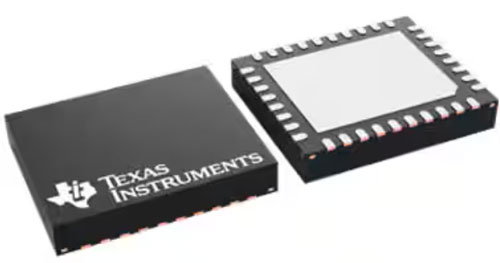Battery Charge Controller with Lift Voltage to Meet Growing Power Needs
Increasing reliance on more powerful battery-powered devices has led product designers to build different battery chargers for each desired application. Texas Instruments (TI) offers a more efficient method of charging high power density batteries over a wide range of voltages with its boost-voltage battery charge controllers. With USB Power Delivery (USB PD) Extended Power (EPR) standard applications, the device can also be configured for bi-directional charging.
Instead of developing a separate battery charger for each application, designers can use the IT BQ25756 (Figure 1) battery charger integrated circuit (IC) with wide voltage input (VIN) and voltage output (VOUT) to create a general-purpose charger solution that can be used with different input adapters and battery configurations. Instead of designing separate chargers for 36 V e-bike batteries and 48 V batteries, designers can develop a universal battery charger for both models, reducing design iterations and costs.
Figure 1: Instruments' BQ25756 bi-directional lift voltage battery charge controller.
Designers can utilize the BQ25756's customizable on-board charging profiles to meet the specific needs of each battery, including high cell counts, high operating voltages, and multiple battery chemistries. They can easily transition to charging next-generation electrified products and provide an optimal charging experience for a variety of applications such as smartphones, power drills, e-bikes, portable chargers and solar panels.
The switch-mode boost controllers operate over an input voltage range of 4.2 V to 70 V and can support a wide range of lithium-ion, lithium polymer or LiFePO4 battery chemistries. For lithium-ion and LiFePO4 chemistry batteries, the device checks the battery voltage and charges the battery in different stages: trickle charge, pre-charge, constant current (CC) charge, and constant voltage (CV) charge.The BQ25756 can charge 1- to 14-cell lithium-ion batteries or 1- to 16-cell LiFePO4 batteries.
When in reverse mode, the device draws power from the battery and regulates the input voltage, while adding a constant current loop for protection to support USB-PD EPR power profiles. USB PD EPR enables the development of applications where a battery pack can be used as a charging source for other devices with variable charging profiles, such as an electric lawn mower battery charging a consumer cordless vacuum cleaner.
The USB-C power and data connector gained considerable market penetration when Apple announced in 2023 that it would adopt the USB-C power and data connector on the iPhone 15 model. The European Commission has mandated that only USB-C adapters be used in new mobile devices such as phones, tablets, and even keyboards and headphones by the end of 2024.
Many devices and charging systems were designed to the earlier USB PD specification, which supported power requirements of up to 100 W. This was considered the standard power requirement for USB. This is considered the standard power range (SPR) for USB, and the EPR can support up to 240 W of power. While the TI BQ25756 can support applications beyond USB-C PD, the development potential of this growing specification is exciting.
Designers envisioning a more universal charger must still consider the reality that different devices rely on batteries with widely varying cell counts and voltage requirements. This is where TI's step-up/down battery charge controllers play an important role.
When a device is charging, a lift-voltage battery charger can step down the source voltage if it is higher than the battery voltage, or step up the source voltage if it is lower than the battery voltage. The BQ25756 enables efficient charging over a wide voltage range with high accuracy, 0.5% charge voltage regulation and ±0.3% charge current regulation. The device operates in I2C host-controlled charging mode and supports standalone charging mode with resistor programmable limits.
The TI controllers also feature automatic maximum power point tracking (MPPT) for solar charging, which ensures optimal performance of the solar panels. Battery chargers using the MPPT algorithm automatically find the maximum power point (MPP) of solar panels under varying sunlight conditions. The wide VIN and VOUT ranges of TI's step-up/down battery charger controllers support a wide variety of solar panel output voltage values.
Conclusion
TI's BQ25756 bi-directional lift-voltage battery charge controller enables general purpose charging solutions with the highest power density for industrial applications. The industry's first uncompensated lift-voltage charge controller has an input voltage of up to 70 V and an operating range of up to 14 cells. This powerful device is a new option for product designers eager to develop a new generation of chargers that can support a wide range of applications and devices.
Are you intersted in electronic components? More on our official website: https://www.ichome.com/ .
